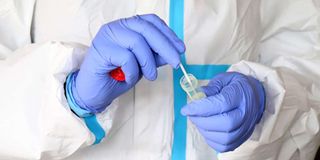Officials take back seat as Covid-19 marches on

A health worker collects a sample for Covid-19 testing from a resident of Kibera, Nairobi, on October 18, 2020.
What you need to know:
- The virus is spreading fast in urban and rural counties – including Uasin Gishu, Kakamega, Kericho, Nairobi, Mombasa, Nakuru, Bungoma and Turkana.
- But what is worrying is the carefree attitude exhibited by the political class, which could be leading Kenyans to the slaughterhouse.
As Covid-19 infections in Kenya crossed the 50,000-mark yesterday, everything pointed to a potential health disaster.
Infections are ravaging communities in counties, hospitals are overflowing with patients and health workers are down, limping or shaken as the pandemic marches on undeterred.
The virus is spreading fast in urban and rural counties – including Uasin Gishu, Kakamega, Kericho, Nairobi, Mombasa, Nakuru, Bungoma and Turkana.
But what is worrying is the carefree attitude exhibited by the political class, which could be leading Kenyans to the slaughterhouse.
Mega rallies that pay no attention to health guidelines and protocols are held daily.
Coupled with this is the collapse of Health ministry’s track, trace and isolate test strategy that had been employed to halt the pandemic.
From a chaotic testing regime to collapsed contact-tracing and an overwhelmed health system, the ministry is now taking comfort on the sidelines, watching as the disease ravages communities.
With hospitals operating at almost 90 per cent bed capacity due to virus admissions, it seems the country’s Covid-19 strategy is on free wheel.
When President Uhuru Kenyatta relaxed the restrictions in late September, counties were at different stages of the pandemic, with most having few cases.
This also saw the Ministry of Health engage a lower gear in its testing regime, amid talks of “flattening the infection curve”.
Behaviour relaxation
“There is behaviour relaxation, and this is dangerous,” Senator Sylvia Kasanga who chairs the House Covid-19 Committee said then.
Unfortunately, nobody seemed to pay attention.
The virus has reached almost every corner of the country, chocking the healthcare system.
Hospital admissions and fatalities are increasing daily.
Kenya’s Covid-19 positivity rate hit an all-time high of 20.5 per cent when 836 cases were reported from a sample of 4,076 yesterday.
In the past five days, a record 64 deaths have been reported, with the national toll now at 934.
As of yesterday, some 38 patients were in intensive care, 15 on ventilatory support and 61 on supplementary oxygen from which 25 are in the high dependency unit.
So how did the country get it wrong?
Kenya dropped its core strategy of track, trace and test mostly on cost concerns even as billions of taxpayers’ money was looted in the Kenya Medical Supplies Agency (Kemsa) and other scandals.
Last week, Health Cabinet Secretary Mutahi Kagwe indicated that the country could not afford mass testing, even as the disease hits communities in rural and marginalised counties like Turkana.
“Testing depends on the availability of reagents. We are target-testing not mass-testing,” the Cabinet Secretary said.
“The high positive figures are because of increased testing. However, the positivity rate is same. This means community infections are high.”
Heath acting Director-General Patrick Amoth contradicted his boss, saying the country needs to conduct at least 7,000 tests a day to fully map its infections, and act on the numbers to contain the pandemic.
Conduct testing
What is more worrying, especially for county governments, is their inability to conduct testing, contact tracing and Covid-19 mapping, leaving everyone to their own devices and second guessing where the second wave of infections could come from.
Experts in July said collapsed contact tracing, coupled with a poor testing regime would cost Kenya, as the virus may have been spreading silently.
The ministry then changed its testing strategy, only targeting symptomatic patients as it argued that “93 per cent of positive cases are asymptomatic”.
Dr Amoth said it was getting expensive testing everyone, with the thin supplies of reagents and supplies.
“Given that most cases in Kenya are asymptomatic or mild, there could be a silent rise of the disease. The lack of symptoms could make it spread silently,” Dr Ambrose Agweyu, the head of Epidemiology and Demography at the Kemri-Wellcome Trust Research Programme told the Nation early this month.
With low numbers of coronavirus in rural areas, mostly because of the low testing, counties that are now battling a rise in infections had assumed that the worst was over.
Dr Benard Muia, a health expert, told the Nation that the low numbers in rural counties was due to low testing rates and slow contact tracing.
“Laboratory-based diagnostics was not adequate. It would have shown the prevalence of the disease in those areas. With no tracing of contacts, we could not say the curve was flattening,” he said.
Additional reporting by Nasibo Kabale and Bernadine Mutanu





